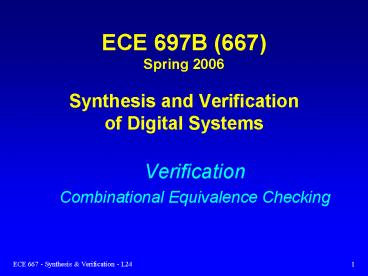ECE 697B (667) Spring 2006 Synthesis and Verification of Digital Systems - PowerPoint PPT Presentation
Title:
ECE 697B (667) Spring 2006 Synthesis and Verification of Digital Systems
Description:
ECE 697B (667) Spring 2006 Synthesis and Verification of Digital Systems Verification Combinational Equivalence Checking Equivalence Checking Two circuits are ... – PowerPoint PPT presentation
Number of Views:127
Avg rating:3.0/5.0
Title: ECE 697B (667) Spring 2006 Synthesis and Verification of Digital Systems
1
ECE 697B (667)Spring 2006Synthesis and
Verificationof Digital Systems
- Verification
- Combinational Equivalence Checking
2
Equivalence Checking
- Two circuits are functionally equivalent if they
exhibit the same behavior - Combinational circuits
- for all possible input values
- Sequential circuits
- for all possible input sequences
3
Application of EC in mP Designs
4
Application of EC in ASIC Designs
5
Combinational Equivalence Checking
- Functional Approach
- transform output functions of combinational
circuits into a unique (canonical) representation - two circuits are equivalent if their
representations are identical - efficient canonical representation BDD
- Structural
- identify structurally similar internal points
- prove internal points (cut-points) equivalent
- find implications
6
Functional Equivalence
- Circuits for which BDD can be constructed
- represent multi-output circuits as shared BDDs
- BDDs must be identical (for the same variable
ordering)
- Circuits whose BDDs are too large
- cannot construct BDDs, memory problem
- use partitioned BDD method
- decompose circuit into smaller pieces, each as
BDD - check equivalence of internal points (cut-point
method)
7
EC Methods
- Structure-independent techniques
- exhaustive simulation
- decision diagrams (DD)
- Structure dependent techniques
- graph hashing
- SAT solvers including learning techniques
8
Functional (Structure-independent) Methods
- Decompose each function into functional blocks
- represent each block as a BDD (partitioned BDD
method) - define cut-points (z)
- verify equivalence of blocks at cut-points
- starting at primary inputs
9
Cutpoint-based EC
Cutpoints are used to partition the Miter
- Cutpoint guessing
- Compute net signature with random simulator
- Sort signatures select cutpoints
- Iteratively verify and refine cutpoints
- Verify outputs
10
Cut-Points Resolution Problem
- If all pairs of cut-points (z1,z2) are equivalent
- so are the two functions, F,G
- If intermediate functions (f2,g2) are not
equivalent - the functions (F,G) may still be equivalent
- this is called false negative
- Why do we have false negative ?
- functions are represented in terms of
intermediate variables - to prove/disprove equivalence must represent the
functions in terms of primary inputs (BDD
composition)
11
Cut-Point Resolution Theory
- Let f1(x)g1(x) ?x
- if f2(z,y) ? g2(z,y), ?z,y then f2(f1(x),y)
? g2(f1(x),y) ? F ? G - if f2(z,y) ? g2(z,y), ?z,y ?? f2(f1(x),y)
? g2(f1(x),y) ? F ? G
We cannot say if F ? G or not
- False negative
- two functions are equivalent, but the
verification algorithm declares them as different.
12
Cut-Point Resolution contd
- How to verify if negative is false or true ?
- Procedure 1 create a miter (XOR) between two
potentially equivalent nodes/functions - perform ATPG test for stuck-at 0
- find test pattern to prove F ? G
- efiicient for true negative
- (gives test vector, a proof)
- inefficient when there is no test
13
Cut-Point Resolution contd
- Procedure 2 create a BDD for F ? G
- perform satisfiability analysis (SAT) of the BDD
- if BDD for F ?G ?, problem is not
satisfiable, false negative - BDD for F ?G ? ?, problem is satisfiable, true
negative
Note must compose BDDs until they are
equivalent, or expressed in terms of primary
inputs
- the SAT solution, if exists, provides a test
vector (proof of non-equivalence) as in ATPG - unlike the ATPG technique, it is effective for
false negative (the BDD is empty!)
14
Structural Equivalence Check
- Given two circuits, each with its own structure
- identify similar internal points, cut sets
- exploit internal equivalences
- False negative problem may arise
- F ?? G, but differ structurally (different local
support) - verification algorithm declares F,G as different
- Solution use BDD-based or ATPG-based methods to
resolve the problem. Also implication, learning
techniques.
15
Implication Techniques
- Techniques that extract and exploit internal
correspondences to speed up verification - Implications direct and indirect
Direct a1 ? f0
Indirect (learning) f1 ? a0
16
Learning Techniques
- Learning
- process of deriving indirect implications
- Recursive learning
- recursively analyzes effects of each
justification - Functional learning
- uses BDDs to learn indirect implications
G1 ? H0
17
Learning Techniques contd
- Other methods to check implications G1 ? H0
- Build a BDD for G H
- If this function is satisfiable, the implication
holds and gives a test vector - Otherwise it does not hold
- Since G1 ? H0 ? (GH)1, build a BDD for
(GH) - The implication holds if (GH)1 (tautology)
18
Summary
- Industrial EC checkers almost exclusively use a
combinational EC paradigm - sequential EC is too complex, can only be applied
to design with a few hundred state bits - combinational methods scale linearly with the
design size for a given fixed size and
functional complexity of the individual cones - Still, pure BDDs and plain SAT solvers cannot
handle all logic cones - BDDs can be built for about 80 of the cones of
high-speed designs - less for complex ASICs
- plain SAT blows up on a Miter structure
- Contemporary method highly exploit structural
similarity of designs to be compared

